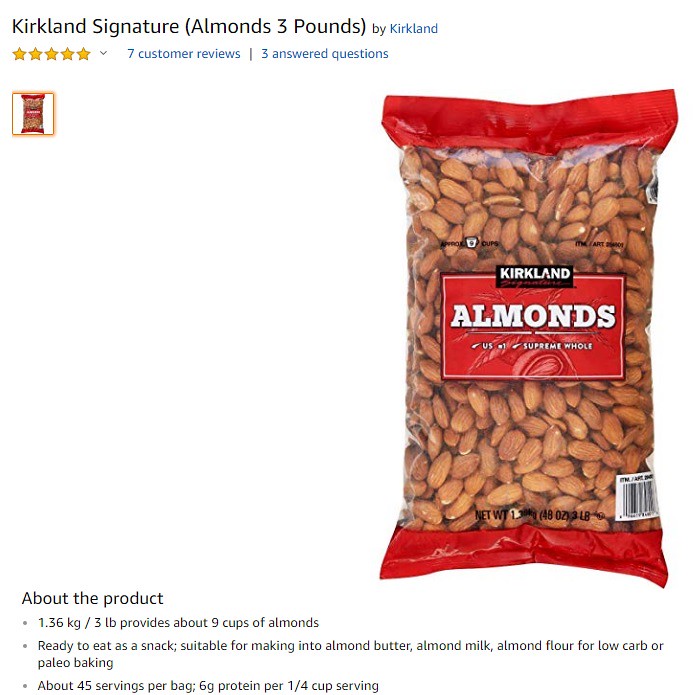Source: Nuts.com
For the last few weeks, each day when I open the daily newsletter from 'Politico Agriculture' the content will inevitably include the following advertisement/statement shown below:
** A message from the Almond Board of California: Almonds grow in a shell, protected by a hull, on trees: products traditionally used for livestock bedding, dairy feed and electricity generation. While current uses ensure nothing goes to waste, we're exploring new applications with greater economic and environmental value. Learn more at Almonds.com/ZeroWaste. **
The first time that I ran across this message, I could not help but think about reporting done by Los Angeles Times a few years ago regarding the 'High Speed Bullet Train' project which would run from Northern California to Southern California -- straight through the central valley -- farm country in California. In that reporting, were accounts of land being taken by eminent domain. Specifically, the reports stated that crops which were 'water intensive' were mostly being impacted. Why discriminate among crops when robbing a land owner of their land? I have no idea.
What was cemented in my mind was the fact that almonds were one of the 'water intensive' crops reported on. After viewing this message/advertisement for the last month (at least), I decided to look further into the amount of water required to grow almonds. Let me walk you through my analysis.
How Much Water Is Required To Grow Almonds?
To start our search, we will just simply follow our usual methodology used in previous analyses. The first question to type into a search engine blank is: How much water is required to grow almonds? The answer is shown below:
To grow a single almond requires 1.1 gallons of water. Wow! That seems like a lot of water for a single nut. Almonds along with other nuts do have nutritional value (as indicated in the podcast which is shown in the image above). Does that potential value outweigh the water cost in California, a state with serious water conservation issues? That might be a topic for another blog post. For now, we want to determine the amount of water required to make different amounts of almonds commonly sold (commonly encountered) in the store for purchase. The results of our dimensional analysis are shown below and surprising to say the least.
As indicated in the image above, the amount of water required to make a single almond is 1.1 gallons of water as shown below:
To state the above equality in terms of a conversion factor, the water cost of growing almonds is shown below:
The conversion factor shown above allows one to determine easily the amount of water required to grow almonds. Although, the conversion factor is stated for a single almond. Almonds are commonly sold in a package of more than a single almond. A search revealed an example of a small package of almonds (3 oz) commonly sold in 7-Eleven convenience stores around the nation and shown below:
Source: Amazon
As you can see in the image above, there are two packages of almonds laid out on a wooden table. Each of these packages holds 3 ounces of almonds. In order to make sense of the amount of water required to grow the almonds contained in a 3 ounce package, the number of almonds per ounce needs to be known. Again, if Google is consulted with the following question: How many almonds in a oz? The answer is shown below:
The last sentence in the paragraph above states that there are 23 almonds in a single ounce. That is the missing conversion factor which is needed to determine the amount of water required to grow a certain amount of almonds. To start, take the 3 ounce bag of almonds shown above.
To determine the amount of water required to grow the almonds contained in a 3 ounce bag sold at a store, the total amount - 3 ounces is multiplied by both conversion factors as shown below:
My goodness. To grow 3 ounces of almonds requires nearly 76 gallons of water. Wow! Now that bag is small compared to what can be purchased on sites like Amazon as shown below:
Source: Amazon
The bag of almonds -- large bag -- is 3 pounds produced by a company called Kirkland. To determine the amount of water required to produce 3 pounds of almonds, the conversion of ounces into pounds needs to be known. Another conversion factor needs to be determined. Again consulting Google with the following question: How many ounces in a pound? The answer is shown below:
The last conversion factor is shown above needed to determine using units of pounds. That is, to determine the amount of water needed to grow 3 pounds of almonds, the total amount of almonds (3 pounds) is multiplied by all three conversion factors as shown below:
The results of the calculation indicates that the total amount of water needed to grow 3 pounds of almonds is equal to approximately 1,214 gallons of water. But wait. In the image above regarding my initial search, there is an additional statement that stated that to grow a pound of almonds requires 1,900 gallons of water. If the link is clicked through to the podcast transcript, you will notice that the reference cited is not listed anywhere on the page.
Where does that leave us? Is the total amount of water required to grow a single almond 1.1 gallons? Does the amount of water required change with volume? To be fair, the podcast transcript from states that there is a large amount of debate as to the total amount of water required to grow nuts in California.
Still, the amount determined in the calculations should be concerning to say the least. Why? As I stated in a previous blog on water use in Los Angeles, the average person in Los Angeles uses around 107 gallons of water a day. That is equivalent to growing roughly a 4 ounce bag of almonds.
The next time you step into a grocery store or liquor store and see a package of almonds sitting for purchase, take a look at the amount sold and determine the amount of water required to grow the almonds in that package. If you get shopping anxiety like I do, this simple exercise will keep your mind occupied while shopping. Further, now you have been liberated to fill the uncomfortable silence at a dinner party or lunch with family with a fun filled facts.
Related Blog Posts:
How Many Women Are Needed To Form A Chain 400 miles Long?
How Effective Are Poultry Corporations At Reducing Salmonella In Their Products?
Parameters: How Much Ice Is Melting In The Antarctic? Enough To Cover Texas?
How many Soy Latte coffee drinks can be made with 135,000 tons of Soybeans?
How many cows are needed to generate 50,000 tons of beef exports?
How many Olympic size swimming pools per day would be filled with 890,000 barrels of oil?
Reader Question: How far would 291 billion Goodyear Blimps reach end to end?











